Cat litter boxes aren’t cheap, but if you’re ready to upgrade your cat’s options, the good news is that plenty of DIY options look and perform just as well as a full-price model specifically built for the job.
From a stylish cabinet with a hidden litter box to a smart-sifting litter box, we’ve rounded up our favorite DIY cat litter boxes for you to choose from.
The 13 DIY Cat Litter Box Plans
1. Sifting Litter Box

| Materials: | 2 plastic nesting boxes, Wooden rod, Screws |
| Tools: | Drill, drill bits |
| Difficulty Level: | Medium |
If you like the look of an expensive sifting litter box but can’t justify splashing out on a full-price version, you can create your own! Simply use two nesting plastic boxes, with the interior box trimmed and drilled with holes to create a sifting net that allows the litter to fall through the holes while catching the waste for disposal.
You might need to figure out exactly what size holes you’re going to need to drill, to correspond with the particle size of your chosen cat litter. This design works best with clumping clay litter.
2. Upcycled Hamper Litter Box
| Materials: | Large hamper, litter box, carpet or fake grass, cat flap, plywood |
| Tools: | Glue, jigsaw |
| Difficulty Level: | Medium |
If you hate the look of litter boxes dotted around the house, consider hiding them in an upcycled hamper! This also has the benefit of giving your cat somewhere private to do their business and keeps dogs far away from the litter box. You can cut a cat-sized hole out of one side of the hamper, and either adds a cat flap or finish the edges with wood.
Adding a base of carpet or fake grass helps stop litter from tracking through your house, and you can add a shelf within the lid of the hamper to store your litter scoop, antibacterial wipes, and anything else you need.
3. DIY Top Entry Litter Box
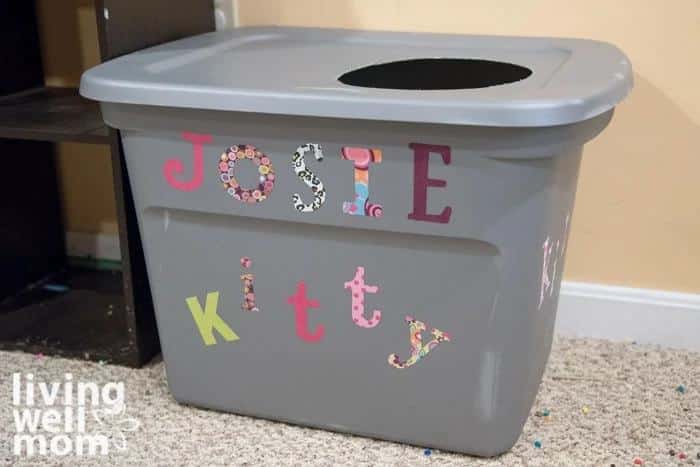
| Materials: | Large plastic box with lid |
| Tools: | Box cutting knife, sandpaper |
| Difficulty Level: | Basic |
Most cats love top-entry litter boxes, but they’re not cheap. By repurposing a plastic container with a lid, you can achieve the same effect for far less money. Make sure you choose a box large enough to accommodate your cat. Once you’ve cut the entry hole, make sure you smooth away any rough edges using sandpaper.
You can glue carpet or rubber matting to the top of the box to help trap any cat litter that’s stuck on your cat’s paws.
4. DIY Limited Mobility Litter Box
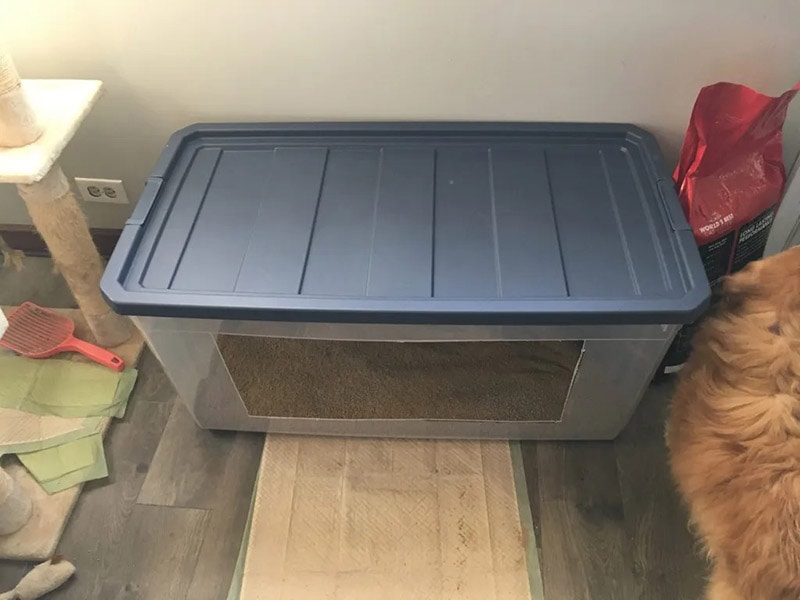
| Materials: | Storage container |
| Tools: | Sander, drill, jigsaw |
| Difficulty Level: | Medium |
Your cat needs somewhere to use the bathroom, but you don’t want to spend a ton or spend a ton of time building a litter box. If that sounds like you, this is the DIY litter box you want. It’s as simple as you can get with a litter box, and you can build it without spending a ton of time or money on it! It might not turn any heads, but it gets the job done, is durable, and your cat will love it.
5. Advanced Litter Box

| Materials: | ¾” sheet plywood, ½” sheet plywood, 1.25″ Kreg screws, ½” screws, 1.5″ inches magnets, handle, mounting plates, tapered legs, wood stain, litter mat |
| Tools: | Tape measure, straight edge, clamps, circular jigsaw, jig saw, power drill, drill bits, kreg jig pocket hole kit, powder sander, sandpaper, foam brush, rags, scissors |
| Difficulty Level: | Advanced |
This is far from the simplest or even the least expensive DIY litter box for your cat, but if you’re looking for a fun DIY project that looks great, this is it. You’re not going to find a litter box like this in the store, and it’s something that fits right into your everyday décor.
But before you start freaking out too much about how complicated it is to build, the guide from Dunn Lumber does a great job of breaking down everything you need to do to build it yourself, even if you’re not a DIY pro.
6. DIY Litter Box Cabinet
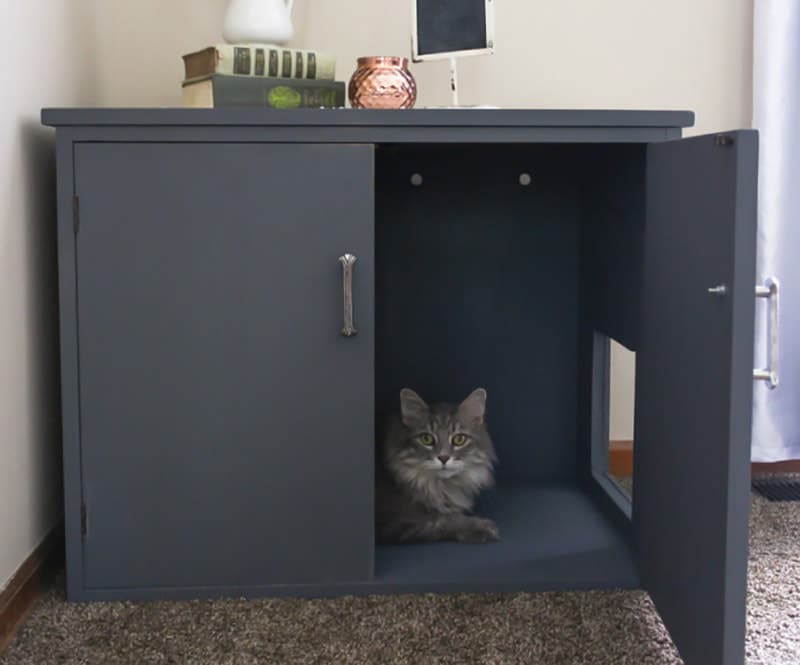
| Materials: | Cabinet, trim pieces, wood filler, chalk paint, clear wax, drawer pulls |
| Tools: | Tape measure, pencil, drill, ¾” spade drill bit, jigsaw, miter saw, liquid nails, clamps, finish sander, sandpaper, paintbrush |
| Difficulty Level: | Advanced |
If you like picking up used furniture from craft stores, garage sales, or other similar events and need to figure out what to do with it, this DIY litter box cabinet is a great option. This guide walks you through everything you need to know to repurpose a cabinet into an outstanding multipurpose hidden litter box for your cat!
7. Modern Plywood Kitty Litter Box
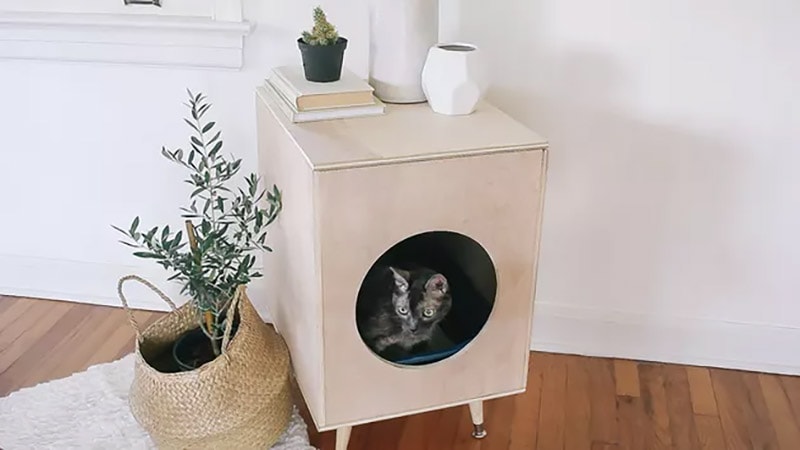
| Materials: | Litter Box pan, ½” plywood sheets, large plate or bowl, tarp or sheet, door hinges, end table legs, wood glue, painter’s tape, nails, table leg angle top plates |
| Tools: | Measuring tape, jigsaw, sandpaper, hammer, power drill, screwdriver |
| Difficulty Level: | Medium |
Plywood is one of the easier materials to work with, and that’s why it’s such a great choice for DIY projects. That’s certainly the case with this modern plywood kitty litter box, allowing you to customize the plywood design to fit the litter pan you decide to use.
Still, it’s versatile, and you can make it multipurpose. With a little stain or paint, you can match it to the décor of just about any room! This guide does a great job of walking you through everything you need to know to make it yourself.
8. DIY Litter Box Bench

| Materials: | 11/16″ plywood, no-mortise hinges, wood filler, wood glue, wood stain or paint, sandpaper, felt floor protectors |
| Tools: | Jigsaw, screwdriver, clamps |
| Difficulty Level: | Advanced |
While some DIY projects require you to have a ton of tools to complete the job, that’s not the case with this DIY litter box bench. You only need a jigsaw, a screwdriver, and some clamps, which is about as simple as it gets.
Even better, not only are you getting an excellent litter box for your cat with this project, but you’re also adding some seating options to your home with it! It’s a relatively simple project, especially if you follow the detailed step-by-step guide here.
9. DIY Hidden Litter Box Cabinet
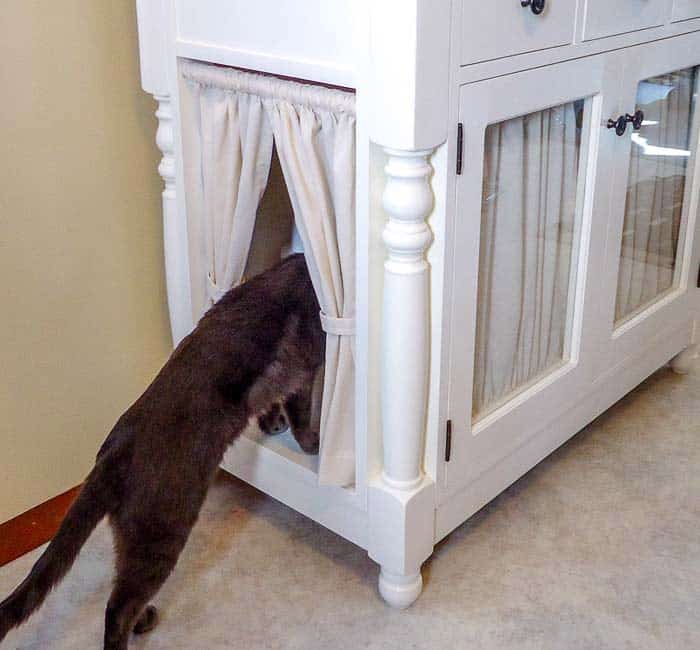
| Materials: | Wood, ¾” brad nails, 1.25″ pocket screws, 1.25″ wood screws, 2″ wood screws, 2.5″ pocket screw, 1.25″ finish nails, ¼” washers, wood glue, knobs, hinges, tension rod |
| Tools: | Tape measure, pocket hole jig, drill, miter saw, circular saw, kreg accu-cut, table saw, brad nailer, hammer, drill bits, countersink drill bit set |
| Difficulty Level: | Advanced |
Beginner DIYers, beware, this is not a simple project. But if you’re up for a challenge and want one of the best-looking litter boxes on the planet, this is a project you’ll want to tackle. In fact, if you do the job right, you can put this litter box anywhere in your home and people won’t even know it’s there!
It’s a complicated project for sure, but it also looks great when you put it all together. The guide does a great job of walking you through everything you need to know to build it, but if it’s your first DIY project, you might struggle with it a bit.
10. Simple DIY Litter Box

| Materials: | Maple plywood, oak dowels, pocket hole screws, magnetic door latches, gripped contact paper |
| Tools: | Pocket hole kreg jig |
| Difficulty Level: | Medium |
While this DIY litter box won’t blow some people away like some of the other options on our list will, it’s still an extremely functional litter box and stands and matches what you could find at many pet stores. You can customize it to the size of your litter box and the opening in your home, though, which makes it well worth building yourself!
Plus, this guide only calls for a pocket hole Kreg jig, so even if you don’t have a ton of tools, you can build it yourself!
11. DIY Mess-Free Litter Box
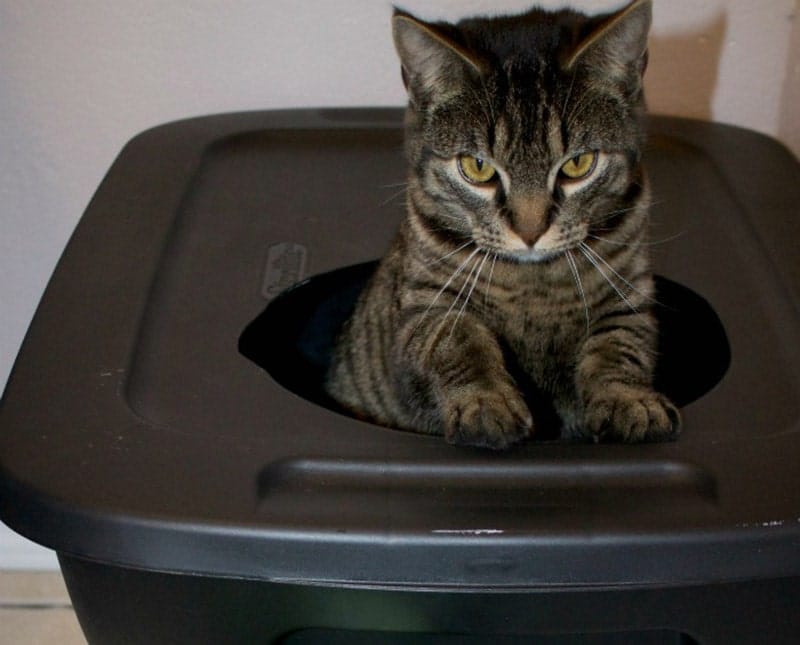
| Materials: | Plastic tote container, sandpaper, plate |
| Tools: | Box cutter, sander, marker |
| Difficulty Level: | Easy |
If you’re not looking for anything too fancy and want to save a bit of money, this project is for you. It’s super simple and doesn’t cost much. In fact, if you already have an extra plastic tote in your home, you might be able to build this litter box without spending any money whatsoever!
The guide does a great job of walking you through what you need to do to make it, but it doesn’t mention sanding down around the opening. To help keep your kitty safe, we highly recommend doing this. It only takes a few minutes to sand it down, making it safer for your cat while they go in and out.
12. Concealed Table Litter Box

| Materials: | Side table, litter box |
| Tools: | Tape measure, pencil, builder’s square, compass, drill, ¼” wood drill bit, variable speed jigsaw, 1/8″ jigsaw blade |
| Difficulty Level: | Medium |
If you’re looking to convert existing furniture into a usable litter box, this guide from HGTV does a phenomenal job of walking you through everything you need to know to make it happen. But to make this project happen, you’ll either need to have a side table already or find one at a yard sale or thrift store.
Once you have the side table you want, it’s a pretty simple project, though! It’s also highly functional and looks great, so we recommend checking it out as a litter box option for your cat!
13. DIY Litter Box Enclosure

| Materials: | Plywood, overlay concealed hinges, sandpaper, edge banding, wood glue, 1.25″ Kreg screws, 1.25″ #6 screws |
| Tools: | Drill, circular saw, table saw, kreg jig, electric sander, jigsaw, kreg concealed hinge jig |
| Difficulty Level: | Advanced |
This DIY litter box enclosure is another outstanding and versatile DIY project you can make yourself if you have the proper tools and know-how. The guide provides the necessary know-how, but it’s up to you to provide the tools!
This DIY litter box enclosure provides a polished look that fits into most décor, and since you can select the wood, stain, and paint, it adds a bit more customization than anything you can find at the store.
You might also like
- 5 Amazing DIY Senior Cat Litter Box Plans You Can Create at Home (With Pictures)
- 10 DIY Cat Shelves You Can Build Today! (with Pictures)
Featured Image Credit: Africa Studio, Shutterstock
Contents
- The 13 DIY Cat Litter Box Plans
- 1. Sifting Litter Box
- 2. Upcycled Hamper Litter Box
- 3. DIY Top Entry Litter Box
- 4. DIY Limited Mobility Litter Box
- 5. Advanced Litter Box
- 6. DIY Litter Box Cabinet
- 7. Modern Plywood Kitty Litter Box
- 8. DIY Litter Box Bench
- 9. DIY Hidden Litter Box Cabinet
- 10. Simple DIY Litter Box
- 11. DIY Mess-Free Litter Box
- 12. Concealed Table Litter Box
- 13. DIY Litter Box Enclosure











